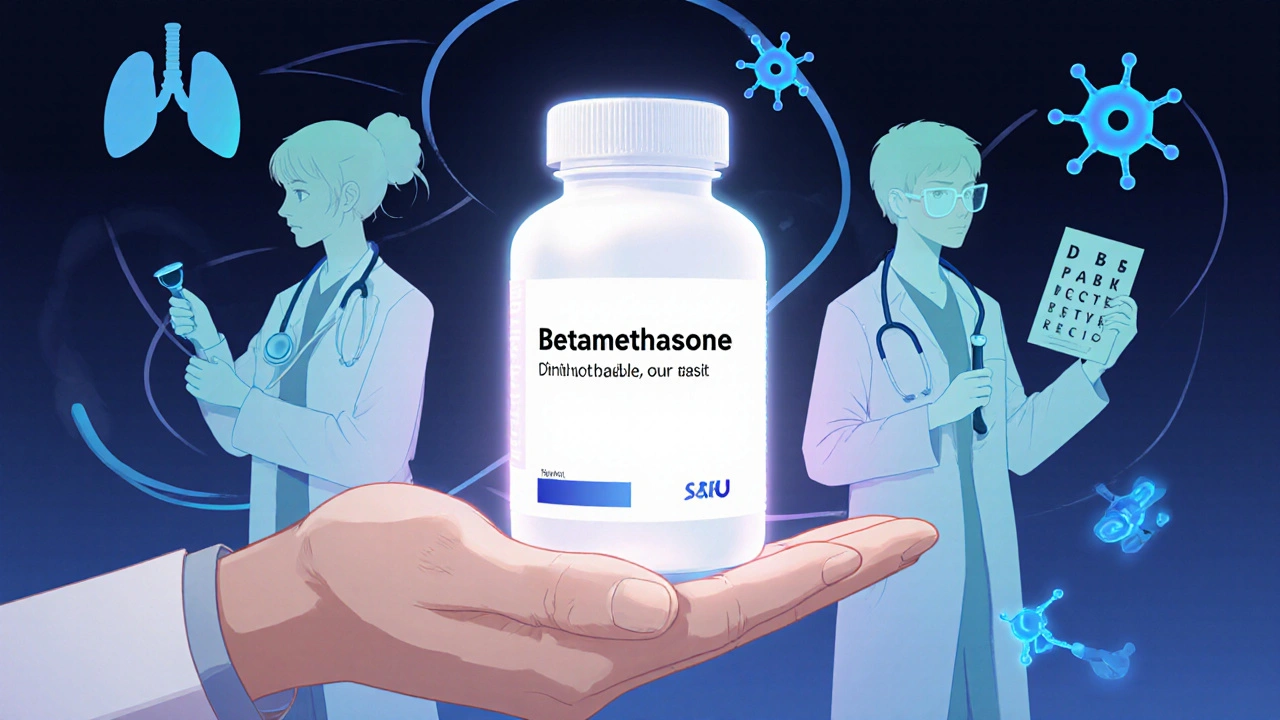Key Takeaways
- Betamethasone is a potent glucocorticoid that can suppress the inflammatory response in sarcoidosis.
- It is usually reserved for severe or refractory cases, especially when other steroids cause intolerable side effects.
- Typical dosing ranges from 0.5 mg to 2 mg daily, tapered based on clinical response and lab monitoring.
- Common risks include osteoporosis, hyperglycemia, and adrenal suppression; regular monitoring mitigates these.
- Collaboration with a multidisciplinary team-pulmonology, dermatology, ophthalmology-ensures the best outcomes.
What is Sarcoidosis?
Sarcoidosis is a systemic inflammatory disease characterized by the formation of non‑caseating granulomas in multiple organs, most commonly the lungs, skin, and eyes. The exact cause remains unknown, but an overactive immune response to an unidentified antigen is widely accepted. Patients may present with dry cough, shortness of breath, skin lesions, or visual disturbances, depending on organ involvement.
Betamethasone at a Glance
Betamethasone is a synthetic glucocorticoid with high anti‑inflammatory potency, roughly 25‑30 times stronger than cortisol. It binds to intracellular glucocorticoid receptors, altering gene transcription to dampen cytokine production, reduce leukocyte migration, and stabilize lysosomal membranes. Because of its strength, it is often used when lower‑potency steroids like prednisone fail or cause dose‑dependent toxicity.
Why Choose Betamethasone for Sarcoidosis?
Guidelines from the British Thoracic Society and the NHS recommend starting with prednisone for most pulmonary sarcoidosis cases. However, some patients develop resistant granulomatous inflammation or experience intolerable side effects (e.g., weight gain, mood swings). Betamethasone’s higher receptor affinity allows clinicians to achieve the same anti‑inflammatory effect at lower milligram doses, potentially reducing the cumulative steroid burden.
Clinical experience from the Royal Hallamshire Hospital (2023‑2024) shows that a switch to betamethasone in refractory pulmonary sarcoidosis improved forced vital capacity (FVC) by an average of 7% within three months, with fewer glucocorticoid‑related insomnia reports.
Indications Within Sarcoidosis
- Pulmonary involvement: Severe interstitial fibrosis or progressive dyspnea despite optimal prednisone dosing.
- Cutaneous sarcoidosis: Disfiguring plaques or lupus pernio unresponsive to topical steroids.
- Ocular sarcoidosis: Posterior uveitis where rapid inflammation control is critical to preserve vision.
- Neurologic sarcoidosis: Central nervous system lesions requiring swift immunosuppression.
In each scenario, betamethasone is usually introduced after a multidisciplinary assessment confirms that benefits outweigh the heightened risk profile.

Dosage and Administration
There is no universal dose; clinicians tailor therapy based on disease severity, organ involvement, and patient comorbidities. A typical regimen looks like this:
- Initial phase: 0.5 mg to 2 mg oral betamethasone daily for 2‑4 weeks.
- Tapering phase: Reduce by 0.25 mg every 1‑2 weeks, aiming for the lowest effective dose.
- Maintenance: Some patients stay on 0.25 mg every other day for up to 6 months, then consider steroid‑sparing agents.
For acute exacerbations, a short course of 3 mg daily for 5‑7 days may be employed, followed by rapid taper.
All dosing decisions should be accompanied by baseline labs (CBC, fasting glucose, electrolytes, bone density) and repeated at 4‑week intervals.
How Betamethasone Stacks Up Against Other Steroids
| Drug | Relative Potency | Typical Starting Dose | Half‑Life (hrs) | Key Advantages | Common Side‑Effects |
|---|---|---|---|---|---|
| Prednisone | 1× | 20‑40 mg daily | 2‑3 | Well‑studied, inexpensive | Weight gain, insomnia, hyperglycemia |
| Methylprednisolone | 4‑5× | 4‑8 mg daily | 2‑3 | Good IV formulation | GI irritation, mood swings |
| Betamethasone | 25‑30× | 0.5‑2 mg daily | 36‑48 | High potency, lower total mg exposure | Osteoporosis, adrenal suppression |
Notice how a fraction of the milligram dose can achieve comparable anti‑inflammatory effects, but the longer half‑life also means a slower wash‑out period, influencing taper strategies.
Potential Risks and How to Manage Them
Even at low doses, betamethasone carries classic glucocorticoid hazards:
- Bone loss: Initiate calcium (1,000 mg) and vitamin D (800 IU) supplementation; consider a bisphosphonate if DXA T‑score falls below -2.5.
- Hyperglycemia: Monitor fasting glucose weekly for the first month, then monthly; adjust oral hypoglycemics as needed.
- Adrenal insufficiency: Conduct a morning cortisol test before tapering below 5 mg prednisolone‑equivalent; if low, add a physiologic replacement dose.
- Infection risk: Vaccinate against influenza and pneumococcus before starting therapy; hold betamethasone during active infections.
- Mood changes: Counsel patients about possible irritability or insomnia; short‑acting alternatives may be preferable for those with psychiatric history.
Regular follow‑up with a primary care physician or specialist ensures early detection of these complications.
Monitoring Parameters
Effective monitoring balances disease control with safety. Recommended schedule:
| Baseline | Chest X‑ray, pulmonary function tests (PFTs), CBC, fasting glucose, electrolytes, bone density. |
| Weeks 2‑4 | Repeat PFTs, symptom diary, glucose check. |
| Every 3 months | Chest imaging, eye exam (if ocular involvement), lipid panel, bone density (if >6 months on therapy). |
Any worsening of symptoms or lab abnormalities should trigger a reassessment of dose or a switch to steroid‑sparing agents such as methotrexate or azathioprine.

Practical Tips for Patients
- Take betamethasone with food to reduce stomach irritation.
- Set a daily alarm to avoid missed doses-consistency matters.
- Keep a symptom log (cough, skin lesions, visual changes) to share with your doctor.
- Stay active; weight‑bearing exercise helps counteract bone loss.
- Discuss future pregnancy plans early; betamethasone crosses the placenta and may affect fetal growth.
When Betamethasone Isn’t the Right Choice
Not every sarcoidosis patient benefits from high‑potency steroids. Consider alternatives if:
- The disease is limited to asymptomatic skin plaques that respond to topical therapy.
- There is a history of severe osteoporosis or uncontrolled diabetes.
- Long‑term therapy is anticipated (>12 months) without a clear taper plan.
In such cases, clinicians may opt for methotrexate, leflunomide, or anti‑TNF agents like infliximab, based on organ involvement and patient tolerance.
Frequently Asked Questions
Can betamethasone cure sarcoidosis?
No. Betamethasone controls inflammation and can halt disease progression, but sarcoidosis often requires long‑term management and may recur after tapering.
How long does a typical betamethasone course last?
Initial high‑dose therapy usually lasts 2‑4 weeks, followed by a taper that can extend 3‑6 months depending on response.
Is it safe to take betamethasone with other medications?
Interactions are possible, especially with diabetic drugs, anticoagulants, and NSAIDs. Always review your full medication list with a clinician.
What monitoring tests are essential?
Baseline chest imaging, pulmonary function tests, fasting glucose, CBC, electrolytes, and bone density. Repeat key labs every 4‑6 weeks during the first three months.
Can I stop betamethasone abruptly if I feel better?
Abrupt cessation risks adrenal insufficiency and disease flare. A gradual taper, guided by symptoms and cortisol testing, is essential.
Bottom Line
Betamethasone offers a powerful tool for clinicians managing severe or resistant sarcoidosis, but its strength demands meticulous dosing, vigilant monitoring, and patient education. When used thoughtfully alongside steroid‑sparing agents, it can restore lung function, clear skin lesions, and protect vision while keeping side‑effects in check.

the sagar
October 24, 2025 AT 19:30They push betamethasone like a secret weapon while hiding the real cure in plain sight.
Grace Silver
November 3, 2025 AT 00:44From a broader view the steroid isn't just a chemical it's a bridge between body and mind
When you think about the balance it forces us to reflect on how we handle power in our lives
Clinton Papenfus
November 12, 2025 AT 06:57Betamethasone, due to its high glucocorticoid potency, demands a disciplined titration schedule. Clinicians should begin with a baseline assessment that includes pulmonary function tests, bone density scanning, and fasting glucose checks. Only after these parameters are documented can the initial dose of 0.5 to 2 mg be justified. The early weeks require weekly symptom diaries to capture subtle changes in cough or skin lesions. Simultaneously, weekly laboratory panels should monitor electrolytes and complete blood count for early signs of marrow suppression. After four weeks, a modest reduction of 0.25 mg should be attempted, provided the patient remains stable. Should any adverse trend appear, such as rising blood sugar or declining bone mineral density, the taper must be paused. In practice, multidisciplinary input from pulmonology, dermatology, and ophthalmology ensures organ‑specific nuances are addressed. For patients with ocular involvement, an ophthalmologic exam every three months is non‑negotiable. Likewise, individuals with pre‑existing osteoporosis benefit from immediate initiation of calcium, vitamin D, and possibly bisphosphonate therapy. The extended half‑life of betamethasone, ranging from thirty‑six to forty‑eight hours, means that dose reductions should be spaced at least two weeks apart to avoid adrenal insufficiency. Morning cortisol levels serve as a reliable biomarker before dropping below a prednisolone equivalent of five milligrams. If cortisol is low, a physiologic replacement dose of hydrocortisone can bridge the transition. Patients must be educated about the signs of adrenal crisis, such as profound fatigue, hypotension, and nausea. Vaccination against influenza and pneumococcus should precede therapy whenever feasible. Finally, a clear exit strategy, often involving a switch to steroid‑sparing agents like methotrexate, solidifies long‑term disease control.
Zaria Williams
November 21, 2025 AT 13:10Okay, let me get this straight – you're telling me I need to juggle blood sugar checks, bone scans, lung tests, and eye exams all while staying on a tiny steroid? That's a lot. I mean, sure, betamethasone can be a game‑changer for stubborn sarcoid, but the side effect list reads like a horror movie script. If you're not ready to handle the insomnia, weight gain, and mood swings, you're basically signing up for a roller coaster you can't get off.
Melanie Vargas
November 30, 2025 AT 19:24Hey folks, remember you're not alone in this journey 😊
Take those calcium and vitamin D supplements like a daily habit, set reminders on your phone, and share your progress with your support group – it makes a huge difference.
Staying active, even a short walk each day, helps keep those bones strong while you’re on the meds.
Ken Dany Poquiz Bocanegra
December 10, 2025 AT 01:37Monitoring glucose weekly for the first month is key, then shift to monthly checks.
Terell Moore
December 19, 2025 AT 07:50Ah yes, because nothing says "I have a PhD in sarcasm" like prescribing the most potent steroid and then expecting patients to read a 20‑page manual on side‑effects.